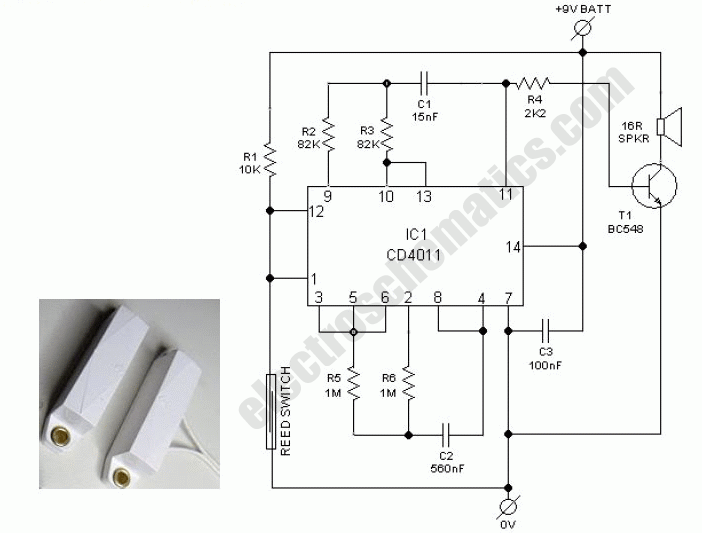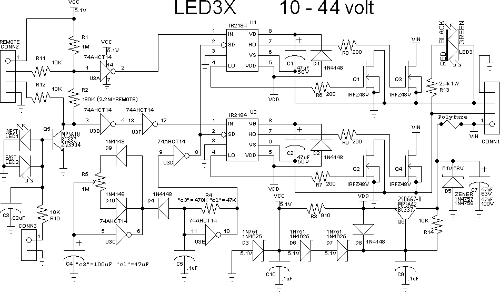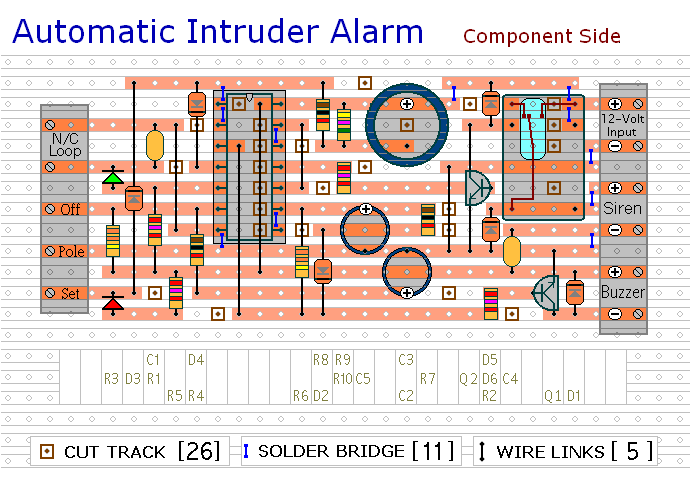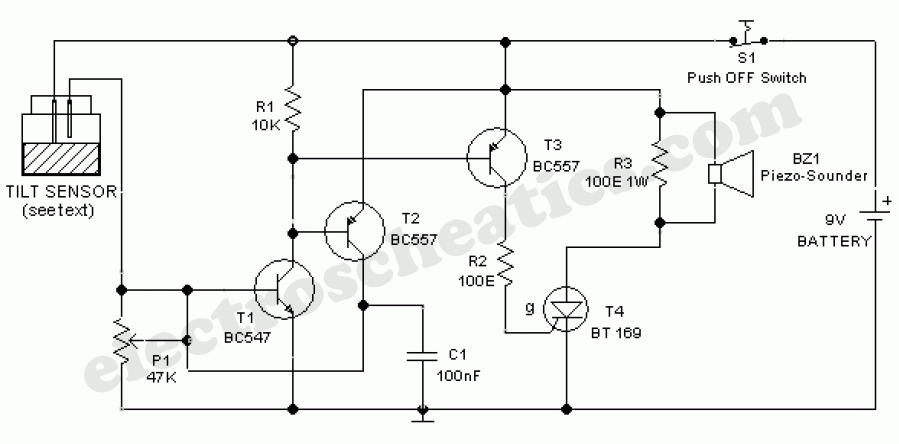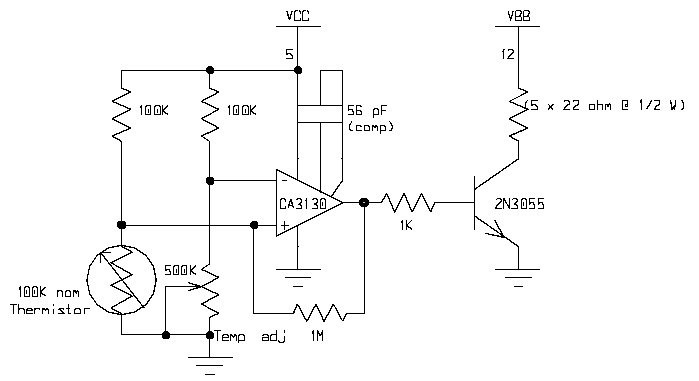
Photo alarm
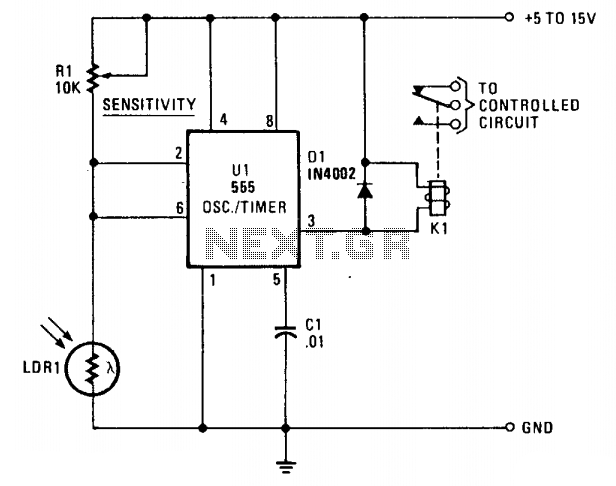
LDR1, a cadmium sulfide (CDS) photoresistive cell, is utilized as the lower leg of a voltage divider between Vcc and ground. The timer terminals 2 and 6 are connected to the junction of the photocell and the sensitivity control resistor R1. The resistance of the photoresistive cell varies inversely with light intensity; it is high under low illumination and low in bright light. The Radio Shack CDS cell 276-116 typically has a wide resistance range—approximately 3 megohms in darkness and 100 ohms in bright light. When the light is interrupted or falls below a level set by the sensitivity control R1, the increase in LDR1's resistance causes the voltage on pins 2 and 6 to rise. If the control is set such that the voltage exceeds 2A Vcc, the relay activates. The relay deactivates when the light level increases and the voltage across the photocell drops below 1A Vcc.
The circuit can be modified by placing relay K1 and diode D1 between pin 3 and ground. In this configuration, the relay deactivates when the voltage on pins 2 and 6 exceeds 0.5 Vcc and activates when it falls below 0.5 Vcc. This modification is beneficial when the relay has single-throw contacts. The opening and closing of the relay contacts occur at different illumination levels, establishing a hysteresis of 1/3 Vcc. This hysteresis is advantageous as it prevents the circuit from oscillating and the relay from chattering in response to minor variations in illumination.
LDR1 serves as a critical component in light-sensitive applications, effectively translating light intensity into a varying resistance value that influences the operation of the relay. The voltage divider configuration allows for precise control of the relay activation threshold based on ambient light conditions. The sensitivity control resistor R1 provides an adjustable parameter that enables the user to set the desired light level at which the relay should activate or deactivate, accommodating various operational scenarios.
The incorporation of hysteresis through the relay modification enhances the stability of the circuit, ensuring that transient changes in light do not lead to rapid on-off cycling of the relay. This stability is essential in applications where consistent relay operation is required, such as in automatic lighting systems or alarm circuits triggered by light levels. The use of a diode in conjunction with the relay also serves to protect the circuit from voltage spikes caused by the inductive load of the relay coil, thus enhancing the overall reliability of the design.
In summary, the described circuit effectively utilizes an LDR in conjunction with a relay to create a light-sensitive switching mechanism, with options for modification to improve performance and reliability in various applications.LDR1, a cadmium sulphide (CDS) photoresistive cell is used as the lower leg of a voltage divider between Vcc and ground. The timer terminals 2 and 6 are connected to the junction of the photocell and SENSITIVITY control Rl.
The resistance of the photoresistive cell varies inversely as the light intensity; resistance is high when the illumination level is low; low in bright light. (The Radio Shack CDS cell 276-116 has a typically wide resistance range—about 3 megohms in darkness and 100 ohms in bright light.) When the light is interrupted or falls below a level set by SENSITIVITY control Rl, the rise in LDRl's resistance causes the voltage on pins 2 and 6 to rise.
If the control is set so the voltage rises above 2A Vcc, the relay pulls in. The relay drops out when the light level increases and the drop across the photocell Ms below lA Vcc. (The circuit can be modified by placing relay K1 and diodeD1 between pin 3 and ground. In this case, the relay drops out when the voltage on pins 2 and 6 rises above V% Vcc, and pulls in when it falls below Vi Vcc. This modification is valuable when the relay has single-throw contacts.) Opening and dosing of the relay contacts occurs at different illumination levels.
This J/3 Vcc hysteresis is an advantage that prevents the circuit from hunting and the relay from chattering when there are very small changes in illumination. 🔗 External reference
The circuit can be modified by placing relay K1 and diode D1 between pin 3 and ground. In this configuration, the relay deactivates when the voltage on pins 2 and 6 exceeds 0.5 Vcc and activates when it falls below 0.5 Vcc. This modification is beneficial when the relay has single-throw contacts. The opening and closing of the relay contacts occur at different illumination levels, establishing a hysteresis of 1/3 Vcc. This hysteresis is advantageous as it prevents the circuit from oscillating and the relay from chattering in response to minor variations in illumination.
LDR1 serves as a critical component in light-sensitive applications, effectively translating light intensity into a varying resistance value that influences the operation of the relay. The voltage divider configuration allows for precise control of the relay activation threshold based on ambient light conditions. The sensitivity control resistor R1 provides an adjustable parameter that enables the user to set the desired light level at which the relay should activate or deactivate, accommodating various operational scenarios.
The incorporation of hysteresis through the relay modification enhances the stability of the circuit, ensuring that transient changes in light do not lead to rapid on-off cycling of the relay. This stability is essential in applications where consistent relay operation is required, such as in automatic lighting systems or alarm circuits triggered by light levels. The use of a diode in conjunction with the relay also serves to protect the circuit from voltage spikes caused by the inductive load of the relay coil, thus enhancing the overall reliability of the design.
In summary, the described circuit effectively utilizes an LDR in conjunction with a relay to create a light-sensitive switching mechanism, with options for modification to improve performance and reliability in various applications.LDR1, a cadmium sulphide (CDS) photoresistive cell is used as the lower leg of a voltage divider between Vcc and ground. The timer terminals 2 and 6 are connected to the junction of the photocell and SENSITIVITY control Rl.
The resistance of the photoresistive cell varies inversely as the light intensity; resistance is high when the illumination level is low; low in bright light. (The Radio Shack CDS cell 276-116 has a typically wide resistance range—about 3 megohms in darkness and 100 ohms in bright light.) When the light is interrupted or falls below a level set by SENSITIVITY control Rl, the rise in LDRl's resistance causes the voltage on pins 2 and 6 to rise.
If the control is set so the voltage rises above 2A Vcc, the relay pulls in. The relay drops out when the light level increases and the drop across the photocell Ms below lA Vcc. (The circuit can be modified by placing relay K1 and diodeD1 between pin 3 and ground. In this case, the relay drops out when the voltage on pins 2 and 6 rises above V% Vcc, and pulls in when it falls below Vi Vcc. This modification is valuable when the relay has single-throw contacts.) Opening and dosing of the relay contacts occurs at different illumination levels.
This J/3 Vcc hysteresis is an advantage that prevents the circuit from hunting and the relay from chattering when there are very small changes in illumination. 🔗 External reference
